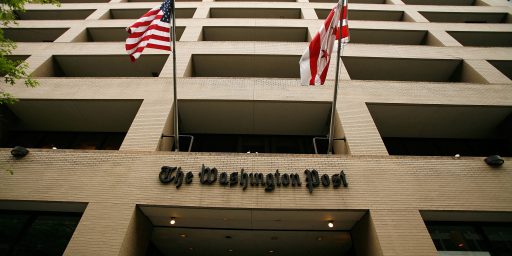The Declining Market for News
Reading habits continue to evolve, not necessarily for the better.

Two stories highlight the radical changes still underway in the news business. At WaPo, editors Robert G. Kaiser and Steve Luxenberg bid “Farewell to Outlook, and nearly 70 years of essays, arguments and criticism.” After a longish, graphic-filled encomium for the Sunday thumbsucker section, they finally explain,
The decision to retire the Outlook section, and to consolidate the paper’s opinion journalism in the editorial department, is a measure of how dramatically the newspaper business has changed in its march from print to digital publication.
Twenty years ago, the Sunday edition was key to the paper’s prosperity. More than 900,000 people bought a copy every week. It was bursting with advertising — inserts, pages and pages of classifieds, and so many display ads that the main news section routinely added more pages to accommodate them. Outlook was a vital part of that Sunday package, which at its peak was delivered to more than 70 percent of households in the Washington metropolitan area. No U.S. paper anywhere could match that figure.
Today, The Post has nearly 3 million paying subscribers. Fewer than 275,000 take the Sunday edition. This article will be read primarily by that dwindling and aging print audience, as well as online readers who might bump into the story while browsing the internet with their phones, tablets or laptops. Many of The Post’s digital readers don’t know an Outlook section ever existed. They know only the many discrete Outlook articles that went viral. And the unheard voices that Outlook editors were among the first to seek out now crowd the internet, where social media offers instant access to all.
After years of shrinking revenue and circulation, an economic transformation is again underway at The Post. The newspaper’s staff has doubled since Jeff Bezos, founder of Amazon, bought the paper in 2013. The Post has opened new bureaus all over the United States and around the world. Editing hubs in London and Seoul allow The Post to act as a global news service, constantly refreshing its stories, photos and film clips. The Post’s YouTube channel, featuring the work of the video division, has 2 million followers.
The “brains section” fulfilled its mission, a mission designed for a print audience. The Post now plays in a different league, which requires new strategies. But wherever Post journalism goes next, Outlook’s spirit of inquiry will live on.
Meanwhile, Poynter’s Rick Edmonds compiles lots of data and anecdotes that “Traffic to local news websites has plummeted” and asks “What happens now?” The problem, ultimately, is a Catch-22.
That in turn leads to consideration of which factors a publisher can control and which they cannot. For instance, high levels of education and income or huge interest in sports are positives for paid circulation — but are givens a publisher cannot change.
As digital subscription efforts mature, retention strategies should naturally get equal weight with acquisition strategies, Frank said. But another preliminary finding will cheer journalists who think round after round of cuts is making news reports too thin to satisfy readers.
“There appears to be a high correlation,” she said, “between newsroom size and digital penetration.” Which is to say that more investment in news goes with better subscription results. Frank cautioned, though, that this is a case where correlation may not be the same as causation — papers that are prospering can afford bigger newsrooms.
One of my publishing sources agreed that news quality was a key variable that could be controlled. “We have to be interesting (to readers) every day with something worth looking at,” he said. “We are looking again at each type of coverage — politics, culture, sports and business — and finding that a lot of time (our approach) is kind of stale.”
So, declining circulation (whether of print subscriptions, digital visits, or both) reduces revenue which in turn incentivizes staff cuts which reduces the quality of the content which leads to lower circulation.
Among the attractions of digital subscriptions is that the cost of serving each additional customer is close to zero. Not so with print. Each additional customer runs up printing and delivery costs. Passing that on with aggressive price increases, in turn, pushes subscribers away and lessens appeal to advertisers.
I would look for more papers to consider dropping days of print delivery and focusing their best content (especially for an older print reading base) in Sunday editions and other remaining days — as The Atlanta Journal-Constitution has been reportedly planning. That’s a partial cure with its own risks, however, since not all print loyalists will embrace the alternative of an e-replica edition.
But note what’s happening with Outlook: one of the country’s flagship newspapers—owned by an Internet mega-billionaire, no less—is cutting a long-running Sunday feature section because that model is outmoded.
As I’ve shared countless times before in the nearly two decades I’ve been writing this blog, I subscribed to the print edition of the local newspaper wherever I happened to be living for the first twenty years or so of my adult life. The last of those, upon my move to Northern Virginia in August 2002, was the Washington Post. It was then and remains a great paper.
As blogging became the primary impetus for my news consumption, though, the value of the print edition of WaPo—and, indeed, print magazines and even broadcast news—declined precipitously. Stories that I encountered in print and couldn’t link were nigh unto useless to me as a blogger.
I don’t recall if I was still subscribing to the paper when I married in October 2005 but I know that my late first wife very much liked to have the print edition of the Sunday Post, so we took it for years and years, probably until her death in 2011. Quite often, I would get an offer to have the other six days’ papers delivered for free so they could inflate their circulation numbers but, if I ever took them up on it, I quickly decided that it wasn’t worth the trouble of collecting the paper seven days a week just to throw it in the recycle bin.
Both because of my blogging habit and the nature of my work, I subscribe to the digital versions of way more outlets than any normal person could justify. These include four newspapers NYT, WaPo, WSJ, and the Dallas Morning News—the latter two only because they offered absurdly cheap promotional rates and the last only for their sports reporting. But, aside from the DMN sports page, I really don’t read any of them as newspapers anymore and haven’t in a very long time. I read articles there just as I do any other website—through various news aggregators, social media referrals, Google searches, and the like.
Obviously, my experience is atypical. But most people can get more news than they have time to read, through one perfectly good source or the other, for free. That’s great for consumers but terrible for the news business. I would say this model is unsustainable but it has looked that way for going on twenty years now and, even though several long-running metropolitan newspapers have shuttered or been reduced to a fraction of what they were, continues to be the case.
For national and international news, at least. For state and local news, much less so.
On the rare occasion when I see a story in the LA Times, Boston Globe, Chicago Tribune, or other local paper that I want to read, they’re almost always paywalled. There’s possibly some way to circumvent the paywall but it’s usually not worth the trouble to figure out. And, as good as though papers may be, they just don’t have enough unique content to justify my subscribing to them as a non-local.
For that matter, even though I subscribe to WaPo, which is my de facto local paper, I don’t actually live in DC but rather in Fairfax County, Virginia. The Post covers our state and politics to some degree but it’s hardly their primary focus and it’s not often highlighted in a way that’s easy to find. And, since my professional interest is in foreign and defense policy and my blogging interest is in US national politics, there’s not a lot of incentive for me to work very hard to seek out local news.
And, again, that’s a way better situation than most would-be news consumers are in. I at least have access to high-quality journalism on major political stories on my state and local government, even if it’s not as in-depth as it would be if I had a true local paper. Most folks can’t get that even if they’re willing to pay for it.
Edmonds ends his piece with this:
The tough times coincide with slow progress on proposals for federal help for local news outlets to hire more journalists. There seems general consensus now that local news is in trouble, but Congress is still a step or two away from doing anything about it.
I honestly can’t imagine that this is ever going to be a high priority for Congress. While I’m much more amenable, for a number of reasons, to beefing up PBS and NPR with tax dollars than I was a decade ago, I can’t imagine how it would work to fund thousands of local outlets. Even aside from the costs, I don’t see how oversight would work.
Regardless, I do worry about the sorry state of our information ecosystem. Whatever the merits of the old days of everyone getting 30 minutes a day of Walter Cronkite or another middle-aged white dudes reading the news to them, there was something to be said for a common sight picture of the state of affairs. And, jokes about “yesterday’s news in your bushes, today” aside, knowing what the hell was going on at City Hall and the State Capitol is really important to a working democracy.






Local news media is fundamentally different than national news, and print is fundamentally different than television. If local print media is to thrive, it needs to find its niche.
Most days I read my local paper, the Baltimore Sun, but I do so via an odd web site, which essentially reproduces the layout of the paper edition in pdf format, and then you can either zoom in to read, or click on an article to give you a more normal electronic version. But I can’t copy text from it or provide a link. So why do I use it? Because their normal website is such a frustrating mess. The same stories show up multiple times, old and new are intermingled, and local and wire-service national news are jumbled together.
Finally, the local news itself has been drastically cut, and that’s fundamental to why someone would come to a local paper rather than a national one. There is a small amount of headline stuff, this or that person indicted, flooding in some neighborhood, a power outage. But most of the everyday local stuff is from a few columnists who write opinion pieces about current issues or reminisce about what B’more was like in the past.
We’ve got a new online only “paper”, The Baltimore Banner, and I’ve subscribed. They are struggling to find their niche, but are actively working on it. I wish them luck.
On the paywall issue, I’ve found Yahoo to be my friend. Almost all the time, a paywall article will have a version available to Yahoo users at no charge. I highlight the hot link and use it as a search term. It’s the only tech thingy I know.
I fondly remember scattering the Sunday Post Disgrace about my apartment back in the day and reading the daily on the bus or on the job site. I haven’t read a print news paper on a regular basis in over 20 years. My wife and I used to go into town on Sundays to eat at the local diner. I would always pick up a copy of the weekly Sullivan Independent News to read thru at the table while we ate. It is very small townish but I found it entertaining anyway and it did keep me up to date with city hall and county news. Unfortunately the diner was sold to some new folks who had different ideas of what a diner was and what kind of foods they served and we didn’t like it so we stopped going. My local news consumption dropped precipitously.
Everything is on line now. I support the news and web sites I think are worthwhile and that I can afford to, but that adds up to only a half dozen or so (this place being one of them). Everything else, I get for free, no ads. If they say, “Turn off your ad blocker or go away” I go away. I don’t blame them, they gotta make money, but I despise pop up and autoplay ads and I just won’t subject myself to them.
It’s a brave new world.
One other thought: If things continue down this road, I can foresee a time when only the Jeff Bezos of the world can afford to distribute the news. Just one more source of influence the super rich will use to their own ends.
Local newspapers have been in retreat since before the internet, that has only accelerated the retreat. In the early 80’s when living in Mpls, I subscribed to both the daily Star Trombone and the NYT’s. Why? While the Strib did a good job of covering state and local news its world and national coverage was horrible, mostly poorly edited wire service copy, where a story would be cut off seemingly in them middle of a paragraph to save space.
The growth of the suburbs has also hindered regional and local papers. To pick on the Strib, they do a good job covering Mpls city government and the city’s neighborhoods, but non-crisis coverage of suburban communities is very thin. The Boston Globe suffers from the same problem. It’s not a wonder that subscribers drop coverage if they’re not finding news about their communities.
As I’ve shared a number of times, 3 careers back, my PhD studies were on the transformation of local journalism.
One thing that struck me when I was doing the historical research for that is that the news market has been slowly shrinking since the late 1920’s. It was during that period where there were estimated to be the greatest number of newspapers (large ones, ethnic ones, political ones, tabloids, etc) and the estimated highest amount of circulation.
While overall numbers and circulation began to decline (partially due to consolidation) the business model lasted far longer (largely because there was no competition). The web changed that and accelerated the issues when it gutted the ad revenue model. But papers were already folding and shuttering before 1995.
A big part of the problem was how American lives were shifting. The 1920’s were argubly also the golden age of mass transit–prior to the mainstreaming of the auto. So people filled their commute time with news. And then with suburbanization, there were still moments in the day (breakfast or after dinner) when there would be time to read the paper (or watch the 1/2 news show… intially 15 minutes).
As more TV programming became available that began to eat into news time. As did the expansion of Network News around the time of JKF’s assassination. Then there started to be 24 hour news radio. And then in 91/92 the advent of the 24 news station. And that all shifted things as well.
And to this point:
All the consolidation has the result of shifting the focus towards Washington. Which is a really bad thing. Especially when local (and even State focused papers) can’t maintain enough investigative reporters. News deserts and becoming increasingly real (especially in smaller and mid-sized cities).
This is because every local news site, some of them very good, require no ad blocker, or registration, or subscription. I love the very good ones – Miami Herald, for example – but I cannot subscribe even to the very good ones. I subscribe to a number of magazines and newspapers, some in the dead tree version or that plus web, but my budget is limited.
I would use a service that would allow me to read Miami Herald and others, one article at a time, for, say, a dollar or two per article. People have talked about this, but nobody has ever put it together.
@Cheryl Rofer:
Agreed. And one thing I don’t understand is why the larger news holding companies (like Gannett) have not explored having a “premium pass” that allows you to access any content in their network.
Or I suspect they have and couldn’t figure out a way to make it work (probably because they overestimated the value of it).
I’ve found myself turning to the websites of area tv stations instead of the paywalled newspaper sites. They cover the same news events. Sometimes there are ads, but as a general rule, they’re not too terribly intrusive.
What I really want and would pay for is something like the NY Times or Washington Post that doesn’t print things it knows to be untrue for the purpose of maintaining access or a veneer of “balance”.
@Stormy Dragon: Washington Post subscription is almost worth it just to see Megan McArdle Bargle and Marc Torture Apologist Thiessen get dragged mercilessly in the comments for the endless dreck they write. Occasionally, McArdle will respond to a comment, only to be filleted further.
It’s one of the more entertaining dramas happening behind the paywall.
@Matt Bernius:
They seem to be heading in that direction. My local daily paper is a Gannett paper. Clearly, they’re using the same layout engine that USA Today uses. The content is one of local, or USA Today, or occasionally another Gannett local (today, the video on my local paper’s front page is the same Oktoberfest video that’s at USA Today). My subscription now includes access to the PDF version of all of the Gannett local papers. That is, a somewhat scaled-down version of the PDF they send to the printer. Recently I have noticed that it’s giving me access to the USA Today “For Subscribers” pieces as well.
It’s not worth what they’re charging me yet, but it’s closer than it was when I started subscribing two years ago. I’m willing to pay the excess because I want the local to survive.
@Michael Cain:
Follow up to previous comment… This prompted me to check, and today I seem to have access to all of Gannett’s papers’ online version, including the stuff tagged “For Subscribers”. Same for USA Today. Including older stuff. First page I visit at each site pops up a subscription offer, but lets me close it and from that point it’s smooth sailing.
Now if they’d just buy up the paper in a few more cities :^)
An odd source of local news: Nextdoor.com. If I want to find out why an LAPD helicopter is overhead, shining a spotlight and yelling unintelligibly above the next street over, I can only really turn to Nextdoor. And there I will learn that several other people are also wondering why an LAPD helicopter is overhead, shining a spotlight and yelling unintelligibly above the next street over.
But Nextdoor’s real strength as a news source is in its pet reporting. Dogs lost, dogs not really lost, dogs found, cats likewise. Nextdoor is all over that beat. Also porch pirates and problematic street people are addressed with all the desperate-to-avoid offending finesse you’d expect from Silver Lake, Los Angeles.
Most fun is coyote news, because some of those lost dogs? Well, some of them are not coming back. The details are vital: just what sized dog did a coyote carry off, and how high was the fence the coyote jumped to get at the dog? Was there desperate shouting and waving of implements? Did the coyote really say, ‘fuck you, old lady’? Was any part of the dog recovered? Not even the dog’s tags?
If you’d gotten your dog one of those tracking chips you could now know the exact location of the guilty but satisfied coyote. You could find him and apologize. Why apologize? Because you understand that this land used to belong to brother coyote, and as an Anglo White person originally from New York, you’re an intruder in lands where the native peoples and the coyote once lived in harmony with nature. Just the same, brother coyote, I know it’s hot, but don’t be drinking out of my pool and eating my pets.
@Michael Reynolds:
Here on the east coast Nextdoor is the same: coyotes, porch pirates, state police helicopters overhead, missing/found cats and dogs.
Exactly. The. Same.
One sign that things are not turning around any time soon: lack of innovation. The street I live on has been closed off a quarter mile away, under construction for more than two years. Why can’t I go to the Sun’s web site and click on it and see any article they have published about it? I want to know what’s happening within walking distance to me this weekend but if I go to the events section I get a list of a thousand things within 25 miles. The search function of all papers I’ve used is a joke. I’ll search for an article I’ve seen two days before and it doesn’t show up.
@MarkedMan: Not that it will help your situation, but MODOT keeps an up to date map showing all construction/serious accidents/road closings due to flooding etc on all state highways (primary and secondary) and interstates. Handy for us living out here in the boonies and folks traveling across the state. If Misery does it, I suspect your state does too.
Maybe your city/county has a similar page.
@Michael Reynolds: @CSK: My Nextdoor is boring in comparison. No coyotes in exurban PNW, we’re too busy at our second and third jobs to pay attention to where the dog/cat is, and the rest is about the homeless camp and why aren’t the police arresting them all with an occasional meth house warning.
I’m sad I have no Nextdoor. The highlights sound entertaining!
I got the BFE equivalent, today. One of the neighbor’s yearling steers got into our hay meadow, we had to ask them to keep an eye on them because the fat bastards think they’re out of feed and have been putting a lot of pressure on our shared fence, sticking their heads through for that “the grass is greener on the other side” deliciousness. 😛
Don’t know if it still exists, but one of the more entertaining publications around in the 1980s was B.A.D. (Boston After Dark) which had personals up the wazoo. The sort of place that would have ads like:”Bisexual Asian lesbian into dominant BSDM looking for a gay albino male sub for spanking and toe-sucking. No freaks.”
I found it hilarious.
@grumpy realist:
B.A.D. was the giveaway version of The Boston Phoenix. I don’t think it exists any longer.